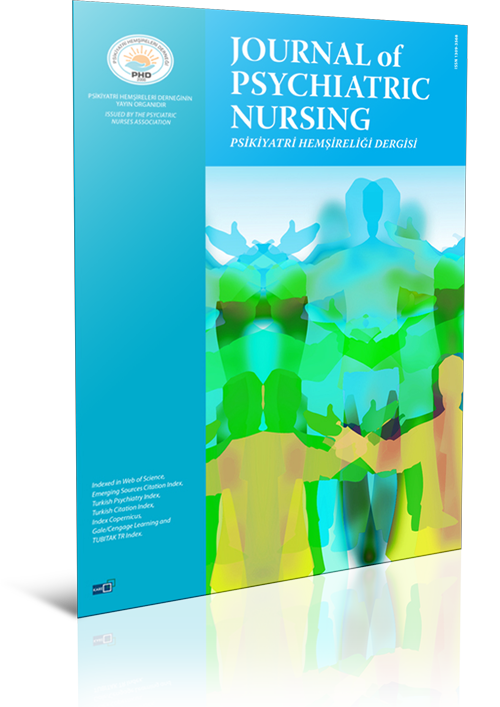
Volume: 10 Issue: 4 - 2019
| 1. | Frontmatter Pages I - III |
| EDITORIAL | |
| 2. | Editorial Nurhan Eren, Nazmiye Kocaman Yıldırım Page IV |
| RESEARCH ARTICLE | |
| 3. | Reliability and validity study for the adaptation of the Camberwell Assessment of Need Short Appraisal Schedule and the Self-Rated Version of the Camberwell Assessment of Need Short Appraisal Schedule to Turkish for Individuals with Severe Mental Dis Gülsüm Zekiye Tuncer, Zekiye Çetinkaya Duman doi: 10.14744/phd.2019.50490 Pages 233 - 240 INTRODUCTION: The study aimed to adapt the Camberwell Assessment of Need Short Appraisal Schedule/Self-Rated version (CANSAS/CANSAS-P) to Turkish, and to test its validity and reliability on individuals with severe mental disorder. METHODS: The sample consisted of 111 individuals with severe mental disorders who were receiving care at five separate Community Mental Health Centers in Izmir. The CANSAS was applied by the Researcher and an Observer to evaluate the participants, while the CANSAS-P was completed by the participants. RESULTS: The content validity index of CANSAS and CANSAS-P was found to be 0.84. Results from the exploratory factor analysis showed that the compliance values of the CANSAS and CANSAS-P were 0.68 and 0.65, respectively. From the confirmatory factor analysis of the scales, the compliance indices were found to be acceptable at 0.075 and 0.054. In the CANSAS compliance analysis conducted to determine the level of agreement between the independent observers the total Kappa value was 0.621. In the parallel form reliability testing, two of the need levels were found to vary between 0.431 and 0.936. DISCUSSION AND CONCLUSION: From the results, this study concludes that CANSAS and CANSAS-P are valid and reliable tools for conducting assessments of individuals with severe mental disorders in Turkey. The CANSAS is administered by a mental health team, while CANSAS-P is completed by the individual with chronic mental impairment, making them both important tools for identifying the views of both the specialist and the individual. It is believed that with these tools, a cooperative service mentality can be formed in planning treatment and care. |
| 4. | Sociodemographic and professional factors influencing the professional quality of life and post-traumatic growth of oncology nurses* Gülay Yılmaz, Besti Üstün doi: 10.14744/phd.2019.43255 Pages 241 - 250 INTRODUCTION: The aim of the study was to evaluate oncology nurses professional quality of life indicators such as compassion fatigue, compassion satisfaction, and burnout as well as post-traumatic growth and its sub-dimensions changed interpersonal relationships, changed philosophy of life, and changed perception of self and the factors that affect them. METHODS: The data for this descriptive research were acquired via a web-based questionnaire between 01 June 2013 and 31 January 2014. A nurse sociodemographic form, Professional Quality of Life Inventory, and Post-Traumatic Growth Inventory were used as data acquisition tools. A total of 182 nurses participated in the study. The effect of independent variables on scale and subscale scores was calculated using the independent-samples t-test and one-way ANOVA. RESULTS: In the statistical evaluation, nurses age, education level, number of children, oncology education, oncology experience, monthly shiftwork, weekly working hours, willingness to select nursing, and willingness to work with oncology patients significantly affected the inventories and their sub-dimension scores (p<0.05). DISCUSSION AND CONCLUSION: Sociodemographic and professional factors affect professional life quality and post-traumatic growth. The oncology nurses working environment should be modified to improve their professional quality of life. Consequently, it is necessary to increase educational and awareness activities for these factors. |
| 5. | The coping methods for stress of multiple sclerosis patients and the related psychiatric symptoms Hilal Seki Öz, Fatma Öz doi: 10.14744/phd.2019.19970 Pages 251 - 261 INTRODUCTION: This study aims to describe the ways that multiple sclerosis (MS) patients cope with stress in their lives and to evaluate symptoms of psychiatric problems. METHODS: The sample was chosen from 245 MS patients who are registered with the Multiple Sclerosis Association Turkey, Ankara Office and agreed to participate in the study. Data were collected by administering an introductory information form, Ways of Coping Inventory (WCI) and the Brief Symptom Inventory (BSI). RESULTS: Patients with MS were more likely to use problem-oriented approaches in coping and most experienced depression and hostility as psychiatric disorders. There was a positive correlation between the helpless approach in the emotional-oriented approach and psychiatric symptoms. DISCUSSION AND CONCLUSION: MS patients should be considered to be at risk for psychiatric disorders. Effective coping strategies that reduce the use of the helpless approach for coping with stress should be supported in terms of preventive mental health. |
| 6. | Validity and reliability of Turkish version of the Supportive Care Needs Survey for Partners and Caregivers of Patients Diagnosed with Cancer Azize Atli Özbaş, Sevcan Kılıç, Fatma Öz doi: 10.14744/phd.2019.37029 Pages 262 - 269 INTRODUCTION: The aim of this study was to culturally adapt and test the psychometric properties of the Turkish version of the SCNS-P&C. METHODS: The sample of the study consisted of 228 cancer patients who were being treated at an oncology hospital. The data were evaluated using SPSS 22 (SPSS Inc., Chicago IL, USA) statistics software. The validity of the structure was determined using confirmatory factor analysis, which was performed with AMOS 21.0. Psychometric testing included internal consistency reliability (Cronbach's alpha coefficient), Spearman-Brown reliability, and validity analyses (confirmatory factor analysis and content validity). RESULTS: The Cronbachs alpha value of the survey was 0.96, and the Spearman-Brown value of the survey was 0.86. The model was validated by confirmatory factor analysis (χ2/SD=2.53, GFI=0.73, IFI=0.87, CFI=0.87, RMSEA=0.08, and RMR=0.088). DISCUSSION AND CONCLUSION: The Turkish version of the SCNS-P&C was found to be reliable and valid for Turkish partners and caregivers of cancer patients, which means that its use can lead to a better understanding of needs. The SCNS-P&C can be used in future nursing research and practice as an assessment tool for partners and caregivers of cancer patients. |
| 7. | What was the distribution of suicide rates by socio-demographic factors between 2007 and 2016 in Turkey? Kamil Alptekin, Veli Duyan doi: 10.14744/phd.2019.59354 Pages 270 - 276 INTRODUCTION: To identify the distribution of suicide rates in Turkey between 2007 and 2016 by gender, age, marital status, and geographical region. METHODS: Suicide statistics obtained from the Turkish Statistical Institute and population data were used to calculate suicide rates by gender, age, marital status, and geographical region. An independent two-sample t-test and one-way analysis of variance (ANOVA) were used to analyze the data. RESULTS: In Turkey, suicide rates are low, but they have slowly risen recently. The suicide rate of men was higher than that of women (p<0.001). The highest suicide rate by age group was among people 75 years and older and the second highest was among people 15 to 24 years old (p<0.001). The suicide rate of divorced people was higher than that of other marital status groups (p<0.001). Average suicide rates in the seven geographical regions of Turkey differed from each other, and suicide rates among men and women in each region varied (p<0.001). DISCUSSION AND CONCLUSION: The suicide rate between 2007 and 2016 was higher in men, particularly for older ages, the divorced, and those living in both socio-economically developed and underdeveloped regions in Turkey. Socio-demographic characteristics must be taken into consideration in studies focusing on the prevalence and prevention of suicide. |
| 8. | Examination of care burden and coping methods in caregivers of individuals diagnosed with bipolar disorder Elif Ayyıldız, Aysun Babacan Gümüş doi: 10.14744/phd.2019.42204 Pages 277 - 285 INTRODUCTION: The aim of this study is to examine care burden and coping methods in caregivers of individuals have diagnosed with bipolar disorder and the correlations of these variables with features caregivers and individuals have diagnosed with bipolar disorder. METHODS: The present study was conducted with 124 caregivers of individuals have diagnosed bipolar disorder who applied Psychiatry Clinic of Hospital, and Psychiatry Clinic of State Hospital. The data were collected by using Questionnaire, Burden Assessment Scale (BAS), and Ways of Coping Inventory (WCI) and data collection forms were applied to the caregivers of the individuals with bipolar disorder using the face-to-face interview method. Data obtained in the study were analysed using SPSS 22.0 software. RESULTS: The BAS scores were significantly higher for the caregivers of individuals have diagnosed bipolar disorder who were single, with low income levels, with rapid cycles, with episodes within the last two years, with impairment of social and occupational functioning, taking drugs, and displaying violent behaviours to others (p<0.05). The submissive and the helpless approach levels were significantly higher for the worker and unemployed caregivers (p<0.05). The seeking social support approach levels were significantly lower for the caregivers of individuals be men, with previous suicide attempts, and drug use; the submissive approach levels were significantly higher for the caregivers of individuals be inpatient; the helpless approach levels were significantly higher for thecaregivers of individuals with impairment, social functioning, displaying violent behaviours to others, and taking drugs; the self-confident and the optimistic approach were significantly lower for the caregivers of individuals drug use (p<0.05). In caregivers, care burden have negative relationships with the self-confident and the optimistic approach; have positive relationships with the submissive and the helpless approach (p<0.05). DISCUSSION AND CONCLUSION: The burden of care of individuals with bipolar disorder is affected by the sociodemographic and clinical characteristics of the patients, the coping methods are affected by the sociodemographic characteristics of the caregiver and the sociodemographic and clinical characteristics of the patients. The increase in the care burden of caregivers is associated with a submissive and helpless approach, and a decrease in self-confidence and optimism. |
| 9. | The relationship between mental health and basic need fulfillment of university students Nesrin İlhan, Melike Güzlük, Emire Özmen doi: 10.14744/phd.2019.50570 Pages 286 - 295 INTRODUCTION: This study was carried out in order to determine the mental health status and the level of basic need fulfillment in university students and the relationship between these two parameters in terms of certain sociodemographic variables. METHODS: Designed as a cross sectional study, this research study was conducted with 609 students studying at a foundation university in Istanbul. The data were collected using a sociodemographic questionnaire, the University Students Basic Needs Scale and the General Health Questionnaire(GHQ-12). Descriptive statistics, Mann-Whitney U test, Spearman correlation analysis and hierarchical multiple regression were used for the data analysis. RESULTS: The mean age of the students was 21.65±2.15, and 63.1% were female. The students mean GHQ-12 score was 1.77±2.48, with the results from this scale showing that 38.9% of the students had psychological symptoms. Students who had a GHQ-12 score of less than 2 had higher scores on the subscales of survival, power, fun, love and belonging need and freedom than those of students whose GHQ-12 score was greater than 2. The results of the regression analysis revealed that the fulfillment of freedom, survival, fun, power needs, as well as economic status and smoking significantly affected the mental health of the university students. DISCUSSION AND CONCLUSION: The study found that students whose basic needs are fulfilled have better mental health. |
| REVIEW | |
| 10. | A technological tool for treating social anxiety: Virtual reality Ömer Özer, Mustafa Kemal Yöntem doi: 10.14744/phd.2019.75010 Pages 296 - 301 Virtual reality-based interventions are the technological instruments that have been found to be effective and used in psychological services. They have been in use for more than 20 years. Virtual reality can be used to treat many mental health issues such as anxiety disorders, depressive moods, obsessive-compulsive disorder and post-traumatic stress disorder. These interventions are based on the exposure method. With the advances in ever-developing technological products and software, more realistic and effective interventions emerge, and programs are tested by many experimental studies. The studies of virtual reality-based interventions toward social anxiety disorder, for which the virtual reality practices are used the most commonly, were examined in this compilation, the current state of virtual reality use in Turkey was explained, and recommendations for future were presented. |
| 11. | Tele-psychiatry Safiye Özgüç, Derya Tanrıverdi doi: 10.14744/phd.2019.37232 Pages 302 - 308 Today, the prevalence of psychiatric disorders is rising, and a significant number of individuals with psychiatric disorders either do not have access to treatment or are unable to complete treatment due to lack of adequate follow-up in the long term. Untreated psychiatric disorders create a burden on the individual with the disorder, their families, and society. In addition to the burdens created by psychiatric disorders, there are many other social and organisational obstacles hindering the use of resources and their quality. This is where tele-psychiatry, which refers to the use of electronic communication and information technologies to provide or support remote clinical psychiatric care, comes in. As a tool offering two-way, real-time, interactive and video-based services on the web to provide psychiatric care, telepsychiatry has the potential to increase access to psychiatric healthcare services, and to improve the quality and availability of care. Increasing the use of tele-psychiatric services, a resource that reflects the advances that have been made in science and technology and applied to the field of healthcare, can provide greater flexibility, allowing healthcare professionals to use their time effectively in administering strong quality care, while, at the same time, offer solutions that address the issue of individuals avoiding the use of psychiatric services due to feeling stigmatized. In the light of these advantages, more studies on increasing the availability of tele-psychiatry services in Turkey should be planned. |
| CASE REPORT | |
| 12. | Psychodynamic formulation in borderline personality disorder: A case study Pervin Tunç, Nurhan Eren doi: 10.14744/phd.2019.36002 Pages 309 - 316 Psychodynamic case formulation examines how symptoms of the patient appeared and constitutes a useful guideline for clinicians because it examines the level of object relations, ego strength, mental capacity, and core conflict, plans the treatment, and predicts prognosis. Borderline personality disorder (BPD) cases display symptoms characterized by dramatic life history, impulsivity, relationship problems, and unstable moods and behaviors. These unstable and multiple symptoms affect the clinical appearance and treatment response of the disorder. People with BPD build up intense transference and countertransference responses and are often perceived as difficult patients by healthcare professionals and nurses who spend the most time with these patients in inpatient services. Therefore, psychodynamic formulation is particularly necessary and useful in BPD cases to understand the patient better and manage the treatment processes. The case presented here reported complaints including mood swings, feelings of emptiness, inability to go to school, bursts of rage, self-injurious behaviors, and suicidal thoughts and attempts. Her expectations from treatment were to control her anger, express herself, be strong in bilateral relationships, and be a normal person. A psychodynamic formulation was done in company with the supervision and the case was diagnosed with BPD. Formulating BPD cases in terms of a psychodynamic perspective may provide more information on thoughts, emotions, and behaviors of the patients. In this study, through the information obtained using psychodynamic interview techniques, impulse, affectivity, mood characteristics, defense mechanisms, selfdom, object relations, and superego of the BPD diagnosed case are discussed. |


















